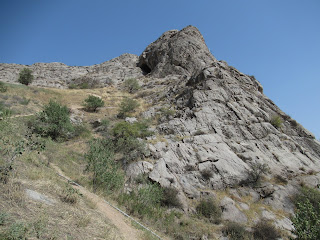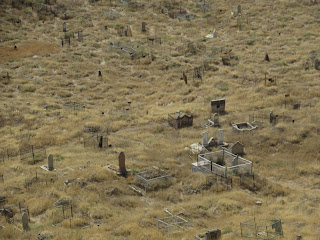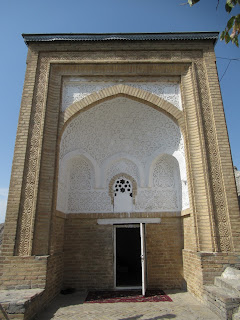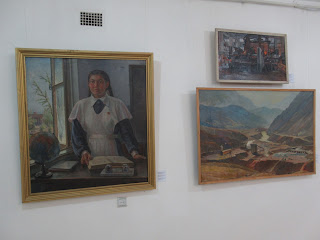After taking an early morning flight from Kyrgyzstan's capital city of Bishkek to its second largest city, Osh, located in the southern part of the country, we checked into the apartment we had rented before setting off to explore the city that locals maintain is older than Rome! King Solomon aka Suleiman to Alexander the Great are credited with founding the city that was used as a half-way point for the Silk Road caravans. It was smashed by the Mongols in the 13th century but Osh bounced back, more prosperous than ever, in the following centuries. If you take a moment and look at a map of Central Asia, you will notice the absurd international borders around Osh, thanks to Joseph Stalin's edicts. That will help to understand why the city's forty percent Uzbek population has more in common with nearby Uzbekistan. Ethnic strife between the Kyrgyz and Uzbek elements rocked the region in 1990 and again in 2010 which had repercussions for the rest of the country.
Enough of politics! The five-peaked mountain that looms over Osh is Suleiman Too or Solomon's Throne and was where we headed on foot. What looked like an amphitheater or a very old fashioned lady's bonnet would be our initial destination.
Before we could begin climbing the mountain, we had a longish uphill walk toward the Suleiman Too Mosque. We entered the grounds and hoped to visit the mosque but the place was deserted which was very unusual.
Protruding from one of Suleiman Too's crags was the Cave Museum, the exit of one of many caves that dot this area.
The museum attempted to describe the region's history and religious development.
Called a Tower of Silence, this was a model of a burial building used by fire worshippers. It would have been helpful to have a time period listed for a frame of reference.
In the Hall of Shamanism, the figure on the left was a male shaman and the one in the middle was a female shaman.
Looking back the way we'd come, we noticed all the caves.
The view back toward the mosque:
I read that, because local people believe in the mountain's sacred and healing powers, pilgrims come to the mountain throughout the day, even during the very late night and lie or sit in the small caves. Rocks in the fertility Ene-Beshik cave were worn smooth by young women "slithering in to aid their motherly aspirations."
Another view of the Muslim cemetery:
Did I say it wasn't an arduous walk up a bit ago? Think I should rethink that, looking at these pictures!
You'd never know it from all the children playing just here but taking a slide with the locals was supposed to fix your back problems. I think it was going to cause back problems for me as I tried to climb up the rocks and then slide down the smooth sloping slab!
At least, I gave the kids something to laugh about as they watched me going down none too gracefully!
Just after that we reached Babur's House, a 1989 reconstruction of a historic prayer room that, according to tradition, was built by a 14 year old, Zahiruddin Babbur, of the nearby Fergana Valley. When he later became the founder of the Mogul dynasty, Babur's place of worship later became highly revered.
While resting outside the prayer space, we saw a few people enter the tiny area. I didn't realize until I peaked in, that there was a holy man inside.
After trying to take the 'perfect' shot the previous afternoon in Bishkek of the Kyrgyzstan flag, I sure recognized it here!
Now that we had just climbed up one side of the mountain, we could descend via the other side into the city center!
This was the end of the hike for us but the start of it for those coming from the city.
You can't see where we started as it was around the other side of the mountain but you can see where we descended from because of the flag!
A short walk away was a small building with the rather grandiose name of the Fine Arts Museum. Admission was just seventy-five cents so we din't expect much! The only employee had to scurry upstairs and turn on the lights for us as we were the only ones there.
I loved the vibrant sky in this painting. None of the tags had any information in English so we didn't know the artists or the names of their works.
This one looked like it was probably of Jayma Bazaar, one of Central Asia's largest and where we were headed next.
Don't think I've ever seen a nude figure made of wood before.
The food cart for vendors who couldn't get away:
Even though we had been in Central Asia for a while and saw a lot of the same things we'd seen in other bazaars, we weren't jaded as this was so vibrant and lively. A plus, too, was we saw very few other foreigners.
As I remarked before, it was so common seeing people sit on their haunches throughout Kyrgyzstan but this was the first time I'd spotted such a young child doing it!
The bazaar had a tea house, something we'd never come across before in all our travels. It looked like only men were welcome there - perhaps a place for them to get away to while their wives and daughters shopped, I wondered?
Did your eagle eyes spot the Barf laundry detergent on the top shelf?! The price was just a buck for the box.
We have seen a gazillion bars of soap like these in all the markets we've been to recently. I guessed it was hand soap but didn't know how to ask. I didn't get close enough to smell them but I was pretty sure I didn't want one of them as a souvenir!
As we wandered through more of the massive market, we saw another tea house with a couple of women in it. As we looked in vain for an empty table, this man gestured us over to join him at his! He was just finishing a pot of tea and soup but stayed long enough while we ordered more tea. Even though there was no common language, we were again made to feel most welcome by this wonderful man. We were very touched when he conveyed via Google translate he had paid for our tea.
Most of the tables in the tea house had elevated benches instead of chairs so the protocol was to remove one's shoes and slide in on the padded seats.
In Kyrgyzstan and here in Uzbekistan where I am writing this post from, the norm is to serve loose tea in a pot with three bowls, not cups, for two people. We quickly learned that you only pour a little tea in your bowl to heat it up and then immediately pour it out into the extra bowl. Then, you fill the bowl with the unstrained tea. After all this time, I still haven't gotten used to drinking tea with leaves in it.
Janina and Suellen: This was the only market I've seen that had yarn in it in either Kyrgyzstan or Uzbekistan which was so surprising because of the huge, huge number of handknit items available for sale in both countries.
As at other markets, we had to keep our wits about us because of men pushing carts along narrow alleys.
Remember all the beautiful designs on the Kyrgyz breads I've shown you in other markets? They were made with these tools. I wanted to bring one home for a souvenir but the weight and surprisingly high price made me reconsider. We've since seen these in a lot of other markets but I still figured that was one thing I didn't need or want, unusual as it was!
The meat section wasn't so quite in your face as the one at the Osh Market in Bishkek had been!
This was obviously the egg section of the market!
Vast quantities of dried apricots are available at every market, I've noticed, here in Central Asia.
Next post: Steven's bad experience at the Osh Animal Market and another case of 'What in God's Name Were We Thinking?'
Posted on October 8th, 2018, from Samarkand, Uzbekistan.
Enough of politics! The five-peaked mountain that looms over Osh is Suleiman Too or Solomon's Throne and was where we headed on foot. What looked like an amphitheater or a very old fashioned lady's bonnet would be our initial destination.
Before we could begin climbing the mountain, we had a longish uphill walk toward the Suleiman Too Mosque. We entered the grounds and hoped to visit the mosque but the place was deserted which was very unusual.
A Muslim cemetery dotted the hillside between the mosque and the mountain.
Beyond the mosque was the beginning of the trail up to the top of the mountain. Part way up, we had a view of the city but it was unfortunately marred by so much pollution, we couldn't see the mountains in the distance. Protruding from one of Suleiman Too's crags was the Cave Museum, the exit of one of many caves that dot this area.
The museum attempted to describe the region's history and religious development.
Called a Tower of Silence, this was a model of a burial building used by fire worshippers. It would have been helpful to have a time period listed for a frame of reference.
This part of the cave was used for Kara-Bulak graves from the 2nd to the 4th centuries.
In the Hall of Shamanism, the figure on the left was a male shaman and the one in the middle was a female shaman.
This was a reconstruction of a Kyrgyz grave from the 7th to the 10th century.
The kep takiya was headwear for a bride from the Osh region during the 19th century.
The Chilten was a room meant to heal people who suffered from spiritual ills. People spent forty days there without eating anything and drinking only water to get rid of depression. I wish I knew when and for how long the Chilten was used and whether it was used equally by men and women.
On the steep ascent to the exit, we passed mangy stuffed animals and images of cave dwellers!
The museum was small and didn't provide nearly as much information as I would have liked as I left not knowing much about the ancient people. These were the views of the inside and outside of the 'amphitheater/lady's bonnet.'
The walk up the mountain on the sunny autumn morning was enjoyable and not arduous. For Muslims, the hike has been a pilgrimage for centuries supposedly because the Prophet Mohammed prayed here.
There were a few dirt paths along the way up for more adventurous types but we were quite content to use the hairpin stairway. Since the mountain was listed as an UNESCO World Heritage Site, I was surprised that people had the option of 'getting off the beaten path.'Looking back the way we'd come, we noticed all the caves.
We certainly saw lots of Muslim families that day but, whether they were on a pilgrimage or just out enjoying the gorgeous Saturday, I don't know.
Even though we were obviously foreigners and also non Muslims, we were made to feel very welcome by everyone we saw even if we were stared at a bit! They all wanted to know where we were from, and the children especially wanted to practice their English with us. The view back toward the mosque:
I read that, because local people believe in the mountain's sacred and healing powers, pilgrims come to the mountain throughout the day, even during the very late night and lie or sit in the small caves. Rocks in the fertility Ene-Beshik cave were worn smooth by young women "slithering in to aid their motherly aspirations."
Another view of the Muslim cemetery:
Did I say it wasn't an arduous walk up a bit ago? Think I should rethink that, looking at these pictures!
You'd never know it from all the children playing just here but taking a slide with the locals was supposed to fix your back problems. I think it was going to cause back problems for me as I tried to climb up the rocks and then slide down the smooth sloping slab!
At least, I gave the kids something to laugh about as they watched me going down none too gracefully!
Just after that we reached Babur's House, a 1989 reconstruction of a historic prayer room that, according to tradition, was built by a 14 year old, Zahiruddin Babbur, of the nearby Fergana Valley. When he later became the founder of the Mogul dynasty, Babur's place of worship later became highly revered.
While resting outside the prayer space, we saw a few people enter the tiny area. I didn't realize until I peaked in, that there was a holy man inside.
After trying to take the 'perfect' shot the previous afternoon in Bishkek of the Kyrgyzstan flag, I sure recognized it here!
Now that we had just climbed up one side of the mountain, we could descend via the other side into the city center!
This was the end of the hike for us but the start of it for those coming from the city.
You can't see where we started as it was around the other side of the mountain but you can see where we descended from because of the flag!
A short walk away was a small building with the rather grandiose name of the Fine Arts Museum. Admission was just seventy-five cents so we din't expect much! The only employee had to scurry upstairs and turn on the lights for us as we were the only ones there.
I loved the vibrant sky in this painting. None of the tags had any information in English so we didn't know the artists or the names of their works.
This one looked like it was probably of Jayma Bazaar, one of Central Asia's largest and where we were headed next.
Don't think I've ever seen a nude figure made of wood before.
We walked past the library through a park full of pretty flowers, couples getting married and kids having a blast on tiny cars. We just needed to hop out of the way if the latter got too close!
The statue was of Kurmanjan Datka, a famous 19th century Kyrgyz female ruler known as the Queen of the South.
Having just been to the Osh Bazaar in Bishkek, we were curious to see how different the bazaar in Osh could be. Even though we've been in some big bazaars before, it didn't take long to realize the Jayma Bazaar was much, much bigger.
Depending on whom you speak to, it either had lots of souvenirs as Steven thought, or items local people wear all the time as I maintained!The food cart for vendors who couldn't get away:
Even though we had been in Central Asia for a while and saw a lot of the same things we'd seen in other bazaars, we weren't jaded as this was so vibrant and lively. A plus, too, was we saw very few other foreigners.
As I remarked before, it was so common seeing people sit on their haunches throughout Kyrgyzstan but this was the first time I'd spotted such a young child doing it!
The bazaar had a tea house, something we'd never come across before in all our travels. It looked like only men were welcome there - perhaps a place for them to get away to while their wives and daughters shopped, I wondered?
Did your eagle eyes spot the Barf laundry detergent on the top shelf?! The price was just a buck for the box.
We have seen a gazillion bars of soap like these in all the markets we've been to recently. I guessed it was hand soap but didn't know how to ask. I didn't get close enough to smell them but I was pretty sure I didn't want one of them as a souvenir!
As we wandered through more of the massive market, we saw another tea house with a couple of women in it. As we looked in vain for an empty table, this man gestured us over to join him at his! He was just finishing a pot of tea and soup but stayed long enough while we ordered more tea. Even though there was no common language, we were again made to feel most welcome by this wonderful man. We were very touched when he conveyed via Google translate he had paid for our tea.
Most of the tables in the tea house had elevated benches instead of chairs so the protocol was to remove one's shoes and slide in on the padded seats.
In Kyrgyzstan and here in Uzbekistan where I am writing this post from, the norm is to serve loose tea in a pot with three bowls, not cups, for two people. We quickly learned that you only pour a little tea in your bowl to heat it up and then immediately pour it out into the extra bowl. Then, you fill the bowl with the unstrained tea. After all this time, I still haven't gotten used to drinking tea with leaves in it.
Janina and Suellen: This was the only market I've seen that had yarn in it in either Kyrgyzstan or Uzbekistan which was so surprising because of the huge, huge number of handknit items available for sale in both countries.
As at other markets, we had to keep our wits about us because of men pushing carts along narrow alleys.
Remember all the beautiful designs on the Kyrgyz breads I've shown you in other markets? They were made with these tools. I wanted to bring one home for a souvenir but the weight and surprisingly high price made me reconsider. We've since seen these in a lot of other markets but I still figured that was one thing I didn't need or want, unusual as it was!
The meat section wasn't so quite in your face as the one at the Osh Market in Bishkek had been!
By the time we left the huge market about three hours later that stretched for kilometers along both sides of the Ak-Burra River, we figured we had to have walked six plus miles that day after having also walked to the mosque and up and around the mountain!
Chess pieces dotted another small park on our way back to our guesthouse. Next post: Steven's bad experience at the Osh Animal Market and another case of 'What in God's Name Were We Thinking?'
Posted on October 8th, 2018, from Samarkand, Uzbekistan.
























































































No comments:
Post a Comment